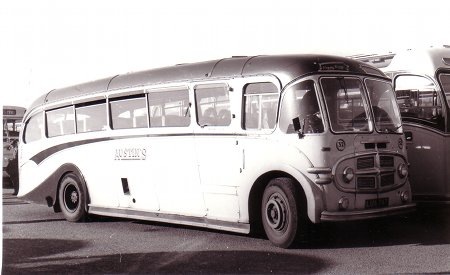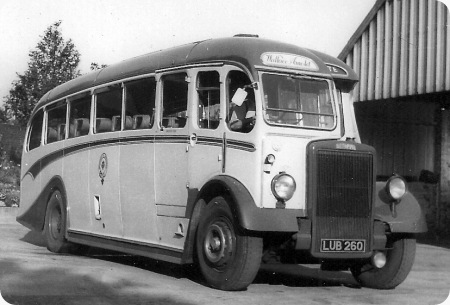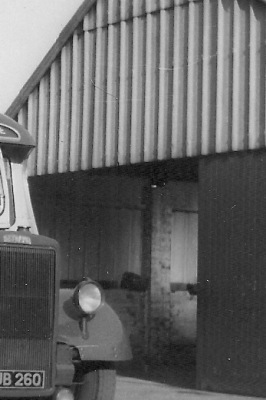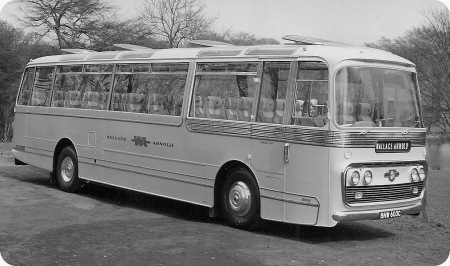Wallace Arnold Tours – Leyland Tiger – LNW 262
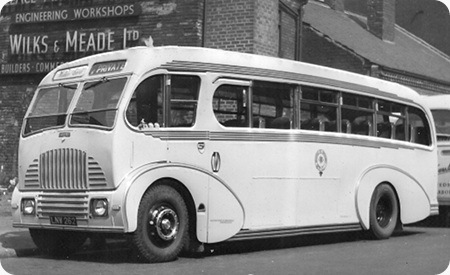
Photograph by ‘unknown’ if you took this photo please go to the copyright page.
Wallace Arnold Tours Ltd
1947/1950
Leyland Tiger PS1
Burlingham FC33F
This photograph is yet another from my dusty collection, taken by an unknown photographer. It shows Wallace Arnold LNW 262, one of a large batch of Leyland PS1s purchase in the immediate post-war years to get a head start on the newly-emerging leisure and coaching market. It was bought in 1947 with a Burlingham C33F half-cab body. In 1950, following the trend towards "modernisation", it reappeared as an FC33F.
At the time, WA were constantly swapping bodies and rebodying chassis to create an up-to-date image at the lowest cost, so I’m not sure if this was a completely new body or simply a rebuilt front end. If it was a new body, what happened to its 3-year old original body?
It was withdrawn in 1957 and saw further service with Wilsons of Hunwick, Prospect of Ferryhill, McClean of Govan and finally to Austins of Stafford in 1963 where it seems to have joined its sister LNW 263.
The only sure thing about this photo is the location – the WA depot and workshops, Chadwick Street, Leeds.
Photograph and Copy contributed by Paul Haywood
———
30/09/12 – 10:44
I’m sorry, but I’ve always preferred the half-cab version of this body. It just looks better. This "grinning" style looks to have been taken as the inspiration for those ‘smiley’ characters which appear on the forum sections of some websites. Was this style of front end some form of inspiration for that variant of the Seagull which appeared on Bedford SB coaches?
Pete Davies
———
30/09/12 – 12:19
If that’s a conversion it’s been done very neatly!
Interesting to note the sign in the background, as Wilks and Meade were coachbuilders themselves!
David Beilby
———
30/09/12 – 12:20
I cant argue with that, Pete. Just one point, some of Northern’s Beadle re-bodies didn’t have a bulkhead behind the driver, but its hard to tell if this one does or not, it may only be a half one, in which case the object of the exercise may have been to leave the passengers feeling less cut off from the driver, that said, I still don’t like it.
Ronnie Hoye
———
30/09/12 – 12:21
My opinion of these sacrilegious "facelifts" intended to deceive the customers in some way is unprintable on a refined Forum like this one. Samuel Ledgard bought a batch of eight most handsome PS1 Tigers with Duple "porch entrance" bodies in 1948. During the madness years of the 1950s these beautiful coaches were subjected to this indignity by the Samlesbury Engineering Company – the first to be treated, LUB 675, was the worst – with small rectangular windscreens with level lower edges – absolutely awful.
Also, in the marketing "spin" frenzy, operators appeared completely oblivious to the maintenance difficulties and to the misting of windscreens which came with these "improvements."
Chris Youhill
———
02/10/12 – 15:28
Wilkes and Meade were a Leeds firm who were bought by Wallace Arnold. They were then set to work on the convoluted post war bodying, re-bodying and partial re-bodying programme (putting full fronts on half cabs). They built many new coaches in the late forties – some for outside customers, and also some buses for Sheffield Corporation. They were finally integrated into Wallace Arnold’s maintenance division and the name disappeared into obscurity.
David Oldfield
———
02/10/12 – 15:30
David B, Wilkes and Meade were actually part of the Wallace Arnold empire so may have had a hand in the rebuilding. It was bought to provide body building/repair facilities for the coach fleet
Chris Hough
———
02/10/12 – 15:32
This looks like a completely new body to me. The trim above and below the windows, and around the wheel arches, belong to the same style of body as the front end, not to the half-cab style. If it is a conversion then it’s a wholesale update, not just a front-end job. Incidentally the trim above and below the windows was carried forward to the Seagull.
Peter Williamson
———
02/10/12 – 15:34
Notwithstanding the impracticalities of full-fronted designs that Chris mentions, but just accepting that it was just the ‘done thing’ at the time, I rather liked the Burlingham ‘SunSaloon’. The grille was a touch flashy and garish I know – so were very many other coach builders’ features in the early fifties – but I always thought that these were very neatly shaped at the front, just as their half cabs had been. Whilst most of us are traditionalists and would much more prefer halfcabs, I think one can understand why coachbuilders turned to full-fronts and full-front rebuilds in the circumstances of the time – it’s just that so many made a dog’s breakfast of the job.
John Stringer
———
02/10/12 – 15:35
This was a new body, a Burlingham Sun Saloon built in 1950. The original body was transferred to a prewar Leyland or AEC as part of the modernisation programme. Wilks & Meade supplied WA with a total of 40 bodies on new and recon chassis in the period 1946-1950, as well as carrying out a good deal of refurbishment and rebuilding work for the operator. A small number of bodied were also built by Wilks & Meade for other concerns. Quite why this coach was at Wilks & Meade’s premises is not clear, one supposes it had been receiving some attention to its body.
Philip Lamb
———
03/10/12 – 06:16
Excellent observations, gentlemen, thank you.
Philip, the Wilks & Meade sign was attached to the side of WA’s workshop/office/canteen building and the Wilks & Meade workshop was further up Chadwick Street. WA’s large depot had entrances from Chadwick Street and the parallel Sayner Road, so this coach was probably parked awaiting duty or mechanical attention.
When WA moved to Donisthorpe Street as a (long-term) temporary measure, prior to the completion of their Tour Terminal, depot and workshops in Gelderd Road, this whole site was taken over by Wallace Arnold Sales & Service, a Vauxhall main dealership – and is now owned by Evans Halshaw. You can still see the footprint of the old depot on Google.
In my time with WA (mid 60s) there was only one chap still employed from the Wilks & Meades days, a very fine man called Jack Lye, who was obviously much used for body repairs etc. I can still see him walking up the street carrying long lengths of beading to be cut, drilled and applied to some accident damaged coach.
Paul Haywood
———
03/10/12 – 10:38
Austin of Woodseaves collected quite a large fleet of Tigers which had started life with Wallace Arnold. If you think the Burlingham Sunsaloon body was an abomination, perhaps you should compare it with this one. LUA 747 started life with a Duple "A type" half-cab body, but was modified with a full-front by their in house bodybuilder Wilks and Meade as shown here. Wilks and Meade produced quite a few similar conversions, all of them using the distinctive tin-front and unmistakable "propeller in an oval" design more usually associated with Plaxtons. Odd that Plaxton should allow this – does anybody know why? (copyright unknown)
Neville Mercer
———
03/10/12 – 17:50
Looks to me as if a complete Plaxton Consort front up to and including the cab window, not just the grille, has been skilfully grafted on. Presumably this was supplied by Plaxton. Makes for an interesting combination!
Philip Lamb
———
04/10/12 – 07:29
Thurgood also produced some bodies (usually on Bedford SB chassis) in the late 1950s/early 1960s which used an almost identical "Plaxton Venturer" front. I also seem to recall that Dodd of Troon (AA Motor Services) had a Foden PVSC6 with a very similar full front rebuild, although this may have originally been bodied, as a half-cab, by Burlingham. My copy of the Foden chassis list is out on loan at the moment, so I can’t check this. Are there no old-time Plaxton employees on this website who might clarify the reason for all these Venturer lookalikes?
Neville Mercer
———
04/10/12 – 07:30
Is the result of the grafting known as a "Duplax"?
Phil Blinkhorn
———
06/10/12 – 07:24
The fitting of the new front end end was done in 1954. From 1952 WA began ordering coach bodies from Plaxton, Plaxton would have been keen to retain their business. Although the work is described as Wilks and Meade to Plaxton design, most, if not all the components must have been supplied by Plaxton. Wilkes and Meade had previously done similar conversions to Yeates design at the same time as Yeates had converted some of WA’s coaches themselves-was this an exercise in keeping Wilks and Meades workshop occupied between car related jobs?
David Hick
———
11/10/12 – 16:04
As mentioned, Wallace Arnold’s rebodying and rebuilding programme in the late 40s/early 50s was complex, and is documented in PSV Circle publications. In fact the featured coach, LNW 262, was one of four in a chain of body changes.
(1) LNW 262, as has been mentioned, was a 1947 Leyland PS1 with Burlingham half cab C33F body, which it carried till winter 1952/3.
(2) HUA 904, a 1939 Leyland TS8 then received the half cab Burlingham body from LNW 262.
(3) APT 464, formerley Wilkinson’s of Sedgefield, was fitted with the 1939 Duple C32F from HUA 904 by Comberhill Motors (dealer).
(4) NUA 753 was a 1950 Leyland PS2/3/Burlingham FC33F whose body was then transferred to LNW 262 to produce the coach depicted. Its chassis then went to Plaxtons for a new Venturer FC35F8 body.
David Williamson
———
12/10/12 – 08:12
David, many thanks for the comprehensive body juggling information. As mentioned in other threads and discussions, WA were very money conscious and never failed to spot a bargain when one arose, and they must have calculated that these complex activities were worthwhile. The strange thing is, I doubt if Mr & Mrs Tourist would have been too bothered about touring in a half-cab or a full-front as long as the seats were comfy and the price was right.
Paul Haywood
———
13/10/12 – 06:33
Interesting point, Paul. It is well known that as soon as underfloor engined coaches made their appearance, halfcabs were considered dead in the water. Despite the regulated environment there was still real competition in the coaching world, and operators could not bear to see a rival operator with more up-to-date stock than they had. And yet, as you say, this may actually have had very little to do with their customers. My family only used coaches for excursions, but I’m quite sure my parents never noticed which of the Albions used by our local operator had full fronts and which were halfcabs. I did of course, but then at the age of 8 I was already a bus freak!
Peter Williamson
———
 Vehicle reminder shot for this posting
Vehicle reminder shot for this posting
———
16/12/12 – 07:37
Regarding Jack Lye from Wilks and Meads (03/10/12 above), there was a George Lye who used to work occasionally in the WA Gelderd Road bodyshop when he was well into his eighties. He loved the job, and was ex Wilks and Meads – could they be the same man? I was at WA 1978 to the end in 2005.
Jon Hartley
———
16/12/12 – 08:38
Jon – George it was! Thanks for that memory jog. Pleased to learn that he was still involved with WA so late on. Every time I pass the Gelderd Road "wasteland" I can’t believe how such a comparatively modern hive of activity could have disappeared so quickly. As you were there to the "bitter end", you must share those sentiments. How are the mighty fallen!
Paul Haywood
Quick links to the - Comments Page - Contact Page - Home Page
